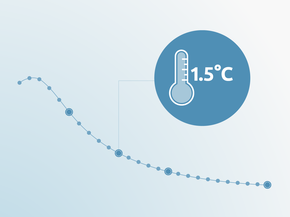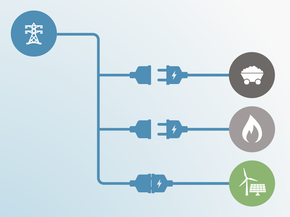Assumptions
Historical data
We obtain energy-related emissions from the IEA Statistics and Balances (IEA, 2017b), a time series from 1990 until 2014, the IEA World Energy Outlook 2017 for 2015 and 2016 values (IEA, 2017a), and the IEA Global energy and CO2 status report 2017 for 2017 values (IEA, 2018).
Non-energy-related emissions are calculated as the sum of CO2 process emissions from industry and non-CO2 emissions. We obtain these from the data submitted to the UNFCCC for 2000 and 2005, and from China’s first Biennial Update Report (BUR1) for 2012 (People’s Republic of China, 2016; UNFCCC, 2017). We assume historical emissions to be correct as currently reported, but there are uncertainties on the inventory. This data is extrapolated to past and future years (up to 2030) using growth rates of the sum of process and non-CO2 emissions. The latter is calculated as follows
- CO2 emissions from processes (excluding cement making) and non-CO2 emissions come from (JRC & PBL, 2014), giving a data series 1990–2010.
- Growth rates from the US EPA projections on non-CO2 emissions are used to extrapolate the non-CO2 emissions series from (JRC & PBL, 2014).
- CO2 process emissions are obtained from (Boden & Andres, 2016) for cement-related emissions, and from (JRC & PBL, 2014) for all other types, again giving a data series 1990-2010. This data series is extrapolated until 2030 using the growth rates in cement emissions from the 2016 IEA Energy Technology Perspectives for non-OECD regions (IEA, 2016).
The resulting time series 1990-2030 on (a) non-CO2 emissions and (b) CO2 process emissions are then added up. Their aggregate growth rate is subsequently applied to the non-CO2 emissions time series 2000-2012. The resulting data series constitutes the “current policy scenario” of non-CO2 emissions.
Pledges
The estimate of the 2020 and 2030 pledges reflects China’s announcement to aim at a share of non-fossil fuels in primary energy consumption of 15% and 20% (excluding biofuels), respectively, as well as reaching a share of 10% gas in primary energy supply by 2020. For these targets, we start from the current policy scenario of the WEO2017 adapt this to cover the most recent announcements/expectations of further capacity additions, and add the effect of recently-adopted targets including the target for gas of at least 10% and a share of 20% non-fossil fuels (excl. biomass), insofar as these are not already reached by the WEO 2017 Current Policies Scenario.
Since the NDC contains the target of peaking CO2 emissions latest in 2030, the implications for what an “NDC scenario” constitutes can be interpreted in a variety of ways—for instance, the least ambitious way would be to assume emissions keep rising and simply peak in 2030, a more ambitious interpretation would be to assume that this peaking happens somewhat earlier. We take the peak level of the “continued coal abatement” scenario as the lower bound of CO2 emissions under the NDC scenario, and the scenario of emissions reaching only the non-fossil and gas targets as the upper end of the range of the NDC scenario, by 2030.
For the calculation of the intensity target, we use historic data from China’s 2017 Statistical Yearbook (National Bureau of Statistics of China, 2017a) and GDP projections from WEO2017 and IMF (IMF, 2017). Our projection calculations are based on the GDP growth rate from the IEA World Energy Outlook 2017 (5.8% annual growth between 2017 and 2025, and 3.7% annual growth between 2025 and 2030). We have used the IMF 2017 as an alternative scenario for 2017 to 2022 (average of 6.2% annual growth).
Based on projections (as described above), however, non-CO2 GHG emissions will continue to grow. This growth will determine the absolute level of total GHG emissions in 2030, and the continuing upward trend points to a need for further policies. China has started to implement some of the actions on non-CO2 emissions indicated in the NDC (see section on current policies), but those are not yet concrete enough to quantitatively include them in our assessment.
We also look at the target to increase the forest stock, under limited data availability: Assuming a wood stock density of around 1.3 tonnes of biomass per cubic metre with a 50% carbon content, the increase in forest stock by 4.5 billion m3 by 2030 from 2005 levels translates into an additional sink of around 430 MtCO2/year, on average, over the period from 2005 to 2030. In comparison, the sink was historically around 400 MtCO2/year. China does not specify whether emissions from forests are included in the carbon intensity target.
Current policy projections
For projections of energy-related CO2 emissions, we use projections from the World Energy Outlook 2017 (IEA, 2017a). We adjust the renewable energy capacity based on the most ambitious numbers among those reported in the Bloomberg New Energy Finance report (Bloomberg New Energy Finance, 2013), official communications from China (NDRC, 2016), and the World Energy Outlook. For non-CO2 emissions, the approach for extrapolating historic data series beyond 2010 is explained under “historical data series”.
China’s cap on coal, at 58% of total primary energy consumption in 2020 (Lin, 2017), would be overshot in 2030 following the WEO2016 projections. In this year’s CAT assessment of China, based on the latest data, we therefore adapt the mix of energy demand based on recent trends in declining coal consumption in China. Coal consumption values for 2014 through 2016 are taken from IEA WEO2017.
We consider two scenarios of further development of coal abatement, representing optimistic and pessimistic assumptions. The optimistic continued coal abatement scenario assumes that a similar rate of reduction as in 2016 can be kept up in the next decade up until 2030. The pessimistic stalled coal abatement scenario assumes that coal use will stabilise after the recent reductions at close to today’s level and no further reductions beyond those in the last three years will occur.
To then quantify emission reductions from the fuel switch, we consider two options of fuel mix development. The first is to maintain the total primary energy demand as in the current policy scenario of the WEO 2017 (from coal towards gas and renewables, which helps achieve the NDC targets on share of gas and non-fossil fuels). The second option is to allow for some flexibility in the total primary energy demand and assume that the coal reduction is accompanied by increasing efficiency, additionally to the already expected development of renewable energy and gas.
To calculate the reductions of HFC23, we assume that a direct correlation exists between HCFC22 and HFC23 in China. This means that we apply the reduction targets for HCFC22 from the NDC to HFC23 emissions in 2010. We compare this against the reference case—the current policy projections—where we use a historic value from the EDGAR emissions base for HFC23 and growth rates from US EPA for HCFC22, again assuming a linear correlation to HFC23. As mentioned above, the resulting reductions are not included in the current policy projections, given the lack of clearly defined policies or actions in the area.
We use Global Warming Potentials from the Second Assessment Report of the IPCC.
Further analysis
Latest publications
Stay informed
Subscribe to our newsletter






